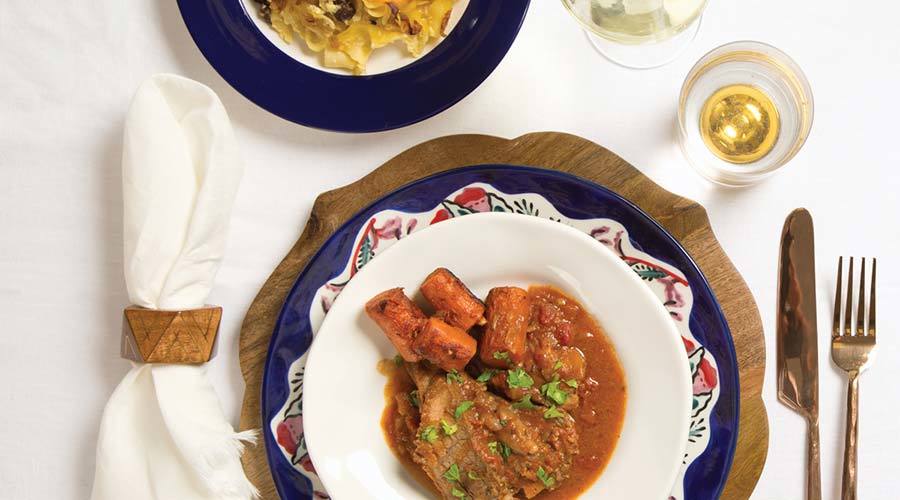
By Anna Caplan
Photo by Ralph Lauer
One family’s Seder may not be considered traditional, but it is filled with traditions. And good food.
By no means is the annual Lazarus-Caplan family Passover Seder conventional.
For starters, there are starters. (I am physically unable to have people over to my house without offering them some sort of crunchy carb-plus-dip appetizer.)
Then there’s the leader of the meal — sometimes my dad, Peter, and sometimes my husband, Jeff. They rotate, seemingly based on who has the shorter attention span that year.
The traditionally hours-long affair, which tells the story of the Jews’ exodus from Egypt and features segues into the symbolic foods eaten, was one year about 10 minutes long, a personal family best.
That’s not to say we ate the entire meal in 10 minutes. Of course not. (It takes my kids, Gabe and Maya, nearly that long to peel the hard-boiled eggs.) It just means we are not a by-the-Seder-book kind of family.
We do have our own traditions. Each year, the table is set with a bevy of where-did-you-find-those, deteriorating-on-the-table-as-we-speak, Passover-related art creations my brothers and I made some 30-plus years ago. Thankfully, they are complemented by a newer trove from Gabe and Maya that is not nearly as speckled by random red wine stains.
For the past several years, the holiday has been celebrated at my house (not at my parents’), where the dining table — usually covered by homework, laundry and miscellaneous detritus — comfortably seats eight and expands to 10 when my brother and his wife visit.
At a certain point in the proceedings, Jeff abruptly and obviously leaves the table to hide the afikomen (a piece of matzo) somewhere in the house, where my kids will find it — hopefully before the dogs — and then come back to the table to hit us up for money.
Finally, the four questions are asked by the youngest one at the table, Maya, who chants the Hebrew in her lovely voice: Why is this night so different from other nights? Which it is — even if our observance diverges from a more, shall we say, scholarly Seder. Passover reminds Jews of springtime and freedom, and, for our clan, it’s a welcome opportunity to come together around the table and share a meal.
Then, quicker than you can sing “Dayenu,” we all tear into the brisket and noodle kugel.
Nannie’s brisket recipe is adapted from one that ran in Gourmet magazine. While apple cider vinegar, broth and crushed tomatoes add richness to the broth, she substituted about 1 cup of ketchup mixed with 2 cups of water.
Great Nannie’s Great Brisket
Serves about 6 to 8
- 3 tablespoons canola oil
- 3½- to 4-pound second
- (deckle) cut briske
- Salt and pepper to taste
- 2 large onions, diced
- 4 carrots, peeled and quartered
- 4 celery stalks, quartered
- 6 garlic cloves, minced
- ¼ cup cider vinegar
- 1 cup reduced-sodium chicken broth
- 28-ounce can crushed tomatoes
Heat oven to 350 degrees.
On the stovetop, add oil to a large, ovenproof pot (a Dutch oven works best). Warm over medium-high heat until oil shimmers.
Season the brisket with salt and pepper, then sear on all sides, starting with the fatty side down. Use tongs, and expect splatters. Meat will be brown on all sides in about 5-8 minutes.
Pull the brisket from the pot and let it rest on a plate.
Meanwhile, turn the heat down to medium. In the same pot, saute onions for about 10 minutes until they are soft. Add carrots, celery and garlic and continue to stir until fragrant (but not until the garlic takes on color), about 7 more minutes.
Add vinegar to deglaze pot, then add broth and tomatoes. Return brisket to the pot, nestling meat in the liquid until almost completely covered. Cover with lid and cook for 2 hours in the preheated oven.
Remove brisket from pot, allow to cool slightly, then cut on the bias, against the grain, into ¼-inch slices. Place brisket back into pot, assembling it back into its original shape.
Return to the oven for 1 hour. Serve hot, with vegetables, or allow to sit until room temperature and refrigerate for later. The brisket is even better the next day.
Julie’s Noodle Kugel
Serves 6
- 1 package kosher for Passover wide noodles (gluten free)
- ½ cup sweet butter
- ½ cup whole milk
- ½ cup sugar
- 16-ounce container sour cream
- 2 large eggs
- 1 tablespoon vanilla
- 2 large slightly tart apples, diced
- ½ cup raisins
- ¼ cup brown sugar
- ¼ cup cornflake crumbs
Heat oven to 350 degrees.
Boil noodles per package instructions. Drain noodles, then combine with butter in the pot. In a large bowl, mix all other ingredients except for the brown sugar and cornflake crumbs. Add noodles and combine until they are coated.
Press into 9-by–13-inch glass dish. Sprinkle with a mixture of the brown sugar and cornflakes. Bake for 30 minutes until golden brown.
